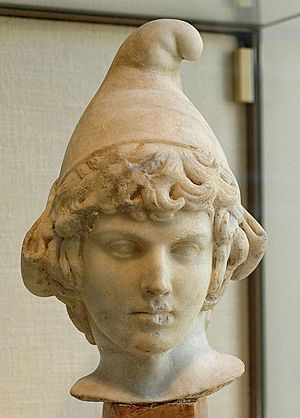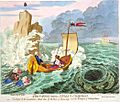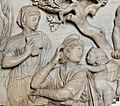Phrygian cap facts for kids

The Phrygian cap or liberty cap is a soft cap, in the shape of a cone, with the apex bent over, which people in antiquity thought had to do with many different peoples in Eastern Europe and Anatolia, including Phrygia, Dacia, and the Balkans. During the French Revolution it came to mean freedom and the pursuit of liberty, but Phrygian caps did not originally have this meaning. The original cap of liberty was the Roman pileus, the felt cap of freed slaves of ancient Rome, which also had to do with Libertas, the Roman goddess of liberty. In the 16th century, the Roman icons of liberty were used again in emblem books and coin studying handbooks where the figure of Libertas is usually shown with a pileus. The most common use of a headgear as a symbol of freedom in the first two centuries after the Roman iconography was commonly used again was in the Netherlands, where the cap of liberty was used in the form of a hat of that time. In the 18th century, the traditional liberty cap was often used in English prints and from 1789 on in French prints, too; but it was not until the early 1790s, that the French cap of liberty was most often used in the Phrygian form.
It is used in the coats of arms of some republics in the place where in a monarchy a crown would be used. It thus came to be identified as a symbol of the republican form of government. A number of national personifications, most commonly France's Marianne, are usually depicted wearing the Phrygian cap.
| 20 centime with Marianne on obverse | |
|---|---|
 |
|
| Obverse: Marianne wearing the Phrygian cap of liberty. | Reverse: Face value and French motto: "Liberté, égalité, fraternité". |
| This coin was minted from 1962 to 2001. | |
Images for kids
-
Prisoner with Phrygian cap (Roman statue from the 2nd century), Louvre
-
Phrygian soldiers. Detail from a reconstruction of a Phrygian building at Pararli, Turkey, 7th–6th centuries BC.
-
Roman Imperial Attis, the consort of Phrygian goddess Cybele wearing a Phrygian cap and performing a cult dance
-
In this 1793 cartoon by James Gillray, who was deeply hostile to the French Revolution, a Phrygian cap substitutes for Scylla atop the dangerous "Rock of Democracy", as Britannia's boat (the Constitution) navigates between Scylla's rock and Charybdis, the "Whirlpool of Arbitrary-Power", pursued by Scylla's "dogs": Sheridan, Fox, and Priestley, depicted as sharks.
-
The 1783 Libertas Americana medal, initiated and designed by Benjamin Franklin, honors the American Revolution and depicts the goddess of Liberty carrying a Phrygian cap
-
Bendis, Thracian goddess of the moon and the hunt, wearing a Phrygian cap. Tanagra-style terracotta figurine, c. 350 BC.
-
A Gnathia-style ceramic vessel with lion-head spouts from ancient Magna Graecia (Apulia, Italy), depicting a blond winged youth with a Phrygian cap, by the "Toledo" painter, c. 300 BC
-
Paris of Troy wearing a Phrygian cap. Marble, Roman artwork from the Hadrianic period (117–138 CE).
-
The "three wise men" with Phrygian caps to identify them as "orientals". 6th-century, Basilica of Sant'Apollinare Nuovo in Ravenna, Italy.
See also
 In Spanish: Gorro frigio para niños
In Spanish: Gorro frigio para niños












